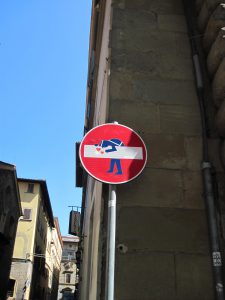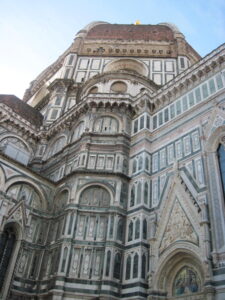
5 Random, Cool Things to See in Florence
So now we’re all aware of the fact that I’ve been to Florence several times and that I love the place so much, and love Italy so much, it’s a major character in three of the books I’ve published. As you can imagine, because of these things, I often end up with people asking me for tips and tricks when they head to the place of my ancestors, aka: the birthplace of the Renaissance. So, I thought it would be fun to talk about a few of the things you don’t always find in guidebooks, but that I think are cool. How did I come up with this list? Last year, when I was visiting my sister in Florence and walking around the city center with my folks, these were the things I pointed out that they both declared, “I didn’t know that.”
- Michelangelo’s graffiti
In the Piazza della Signoria. If you stand directly in front of the Palazzo Vecchio (the old palace), you will see a statue of David by Michelangelo, the original was moved into the Galleria dell’Accademia on the left of the entrance, and on the right, you’ll see a statue of Hercules and Cacus.
On the side of the Hercules statue, on the right corner of the building about four stones up from the bottom, you’ll find a face carved into the stone. This face, my friends is known as Michelangelo’s graffiti.
Now, was it really done by Michelangelo? There’s no real proof, but there are some fun stories surrounding this renaissance face.
Story one: Our friend Michelangelo was cornered into conversation with a man he thought was quite boring, we’ve all be there. When these boring people talk to us, we make grocery lists, mentally clean our houses, or will our cell phones to ring so we can apologize and use the call as an escape. Well, Michelangelo didn’t have a phone, but he did have a knife. So he took it out and began sketching a face into the stone behind his back as the talking droned on and on and one.
Story two: One morning, ol’ Mikey was out for a walk, but when he came to the Piazza, a man who was about to be hung was led past him. Called by some artistic muse, Michelangelo etched the condemned man’s face into the stone.
Story three: as a young, cocky youth. A few artistic thugs claimed that Mikey’s art wasn’t all that great. He disagreed. Someone challenged him, “oh yeah, if you’re so good, then I bet you can’t sketch behind your back, into this stone, right here right now!” And Mikey showed them that he indeed could.
Whatever the truth, it’s a cool story.




- Modern Day Graffiti
Speaking of graffiti, I don’t know about you, but one of the most surprising things to me was the amount of graffiti in Europe.
“As the train began its lumbering pace out of the airport station, I was unable to hold back my wide tourist grin – a mixture of crazed smirk and wide, childlike wonder.
The backsides of gates and buildings were tattooed with layers of graffiti. Innumerable taggers hoping for immortality, perhaps. Wave after wave of illegible words had washed upon the shores of broken glass and rocks and trash; creating a beautiful backdrop for fatigued travelers to gaze upon.
Of course, it might not have been that poetic. It might just be a crap load of graffiti, attempts to define gang lines or a drug dealer’s territory in what had become a really ugly part of town.” – From The Italian Holiday by Nicole Sharp
Florence is not an exception to this, and as you can see, I even immortalized the stuff in my words. However, Florence has some different kinds of graffiti in Florence that are quite entertaining.
As you find yourself walking the cobblestone streets of the city, your attention will be on the shop windows, faded frescoes painted on the side of buildings, dreamy architecture and the traces of Renaissance life that surrounds you. But I urge you to check out the traffic signs when you get a chance.
A few years ago, an artist named Clet Abraham began using street signs as his medium for his art work. His clever use of traffic signs have brought about some interesting commentaries on life and art and rules and rebirth of renaissance in Florence.



- High water
Speaking of signs.
Well, this cool thing is more about plaques.
So, the Arno River is the name of the main river that flows through Florence. Cross one of the bridges in Florence, say the old bridge, aka the Ponte Vecchio, and you can dreamily watch the lifeblood of the city pass beneath your feet. Most of the time, the tame waters look docile. However, they have been quite deadly several times throughout history. The most recent date was November 4, 1966. The Arno River breached its retaining walls and muddy flood waters rushed into the Piazza Santa Croce and into the church, covered the Piazza della Signoria and by 10am the water had reached and entered the Duomo. The water was so high and strong that the bridges were impassable, the city had become a veritable lake. The water reached more than 22 feet in height, and sadly claimed over 30 lives. All that water rushing into the historic city ruined a reported twenty thousand homes, countless cars and over 6000 shops were closed.
The muddy water entered many historic landmarks and damaged or destroyed over 1500 piece of artwork. And the national library lost over a third of their collection.
When the flood waters receded, men and women hurried to help try to save the artwork that was so important to the city. They sloughed back and forth through the muddy streets helping take art work do different locations. These people became known as the ‘mud angels’.
So one of the things they’ve done to memorialize this horrific day, was to place plaques on several walls in the piazzas. They placed these plaques at the height the water reached, 20 to 25 feet above street level.





- The Bull’s Head on the Duomo
The Duomo in Florence is impressive, stand before her in all her glory and she’s an overwhelming example of Italian gothic architecture. There are a lot of stories and ghosts roaming the old girls bones.
One of the lesser known, has to do with the outer façade of the cathedral and involves a stone bull head.
As you face the front of the Duomo, walk around the left a little, the first rounded form you come to, if you look up to the area where the dome just meets the wall, you’ll find the sculpture of a bulls head.
Why, you may ask yourself, is there a sculpture of a bulls head on the Duomo and do we even care? For our purposes today we do care! This is another one of those things in Florence that comes with very little concrete evidence and a lotta lore.
Store One: So one of the stonemasons working on the Duomo was having an affair. But the woman’s husband found out and made her end things. Well, the stonemason was heartbroken. Days and nights pinning for his one true love, but these were the days when you stayed put once you were married. Pinning turned to anger, and so the stonemason carved the head and placed it so the horns of the bull pointed to the man’s house, a curse on the man and a blatant reminder of who the woman really loved.
The second story: Okay, this one is a bit more plausible, but kinda boring. They say that the sculpture of the bull’s head on the Duomo is in remembrance of all the animals that were used in the building of the structure.



- A very very very old pharmacy
Before there was a Rite Aid or Walgreens on every corner, aka the 13th century, do you know where you went when you were sick? In those days you went straight to the perfumery. And in Florence, you would go to the church of Santa Maria Novella, because that’s where the monks started a vegetable garden. Which led to studies in herbal remedies and the concocting of oils and other goods to help cure what ailed you.
Today, world’s oldest pharmacy can still be found at Santa Maria Novella, it’s called the Officina Profumo-Farmaceutica di Santa Maria Novella.
Monks in the 13th century were making oils and perfumes, but in doing so, they were also studying and finding various remedies that herbs and plants could help with.
And they’re still at it! Not the monks, I mean, some of them might have gone to medical school, but there’s more to it today. What I mean, is that the perfumery is still at it.
The pharmacy-perfumery is still in business in the same location today. They continue to manufacture most of their products with the same ingredients and recipes they’ve used for years. And among some of their modern oils and perfumes you can still find traditional elixirs for purchase. You will also find the apparatus the monks used to distill flower water and their original recipe ledgers.
A little fun fact: The monks first prescribed rose water to be used to clean houses after outbreaks of plague.




You can still buy Rose water today. On line no less.
There is so much to see and do in Florence, and the city is brimming with nuances and life. While the museums and galleries are wonderful in their own right, you can find some pretty amazing traces of the past just by walking the streets where the Italian Renaissance began.


